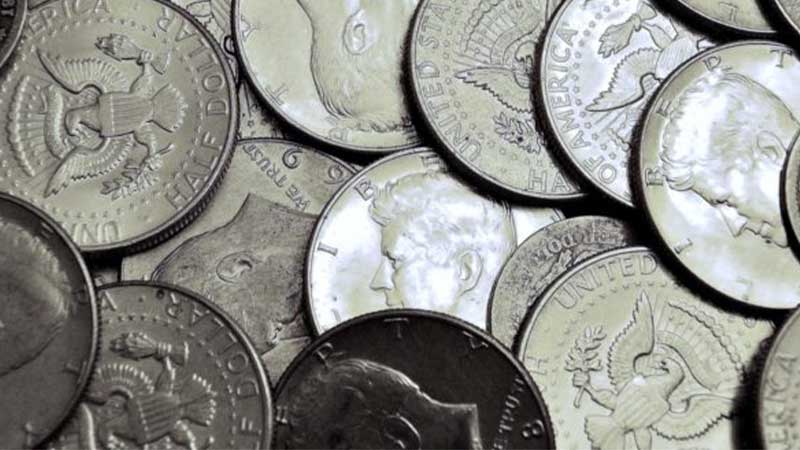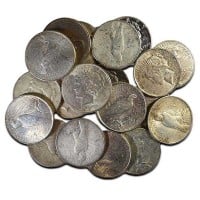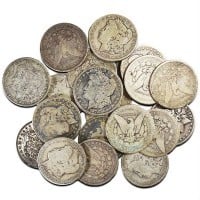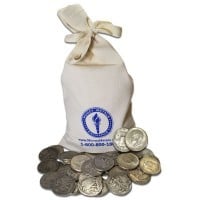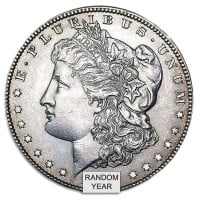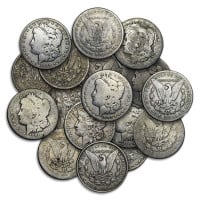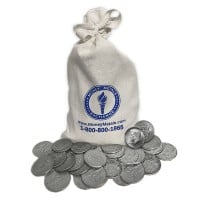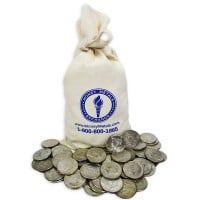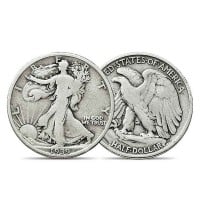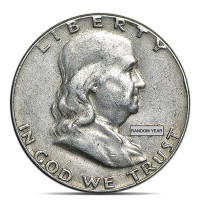Silver Dollars
| Qty | Price Each |
|---|---|
| 1 - 99 | $29.75 |
| 100 - 499 | $28.75 |
| 500 - 1999 | $27.75 |
| 2000+ | Call for pricing |
|
|
|
| Qty | Price Each |
|---|---|
| 1 - 99 | $31.25 |
| 100 - 499 | $30.25 |
| 500 - 999 | $29.25 |
| 1000+ | Call for pricing |
|
|
|
| Qty | Price Each |
|---|---|
| $ 5 Face | $113.00 |
| $ 500 Face | $11,120.00 |
| $ 2000 Face | $44,060.00 |
| $ 5000 Face | Call for pricing |
|
|
|
| Qty | Price Each |
|---|---|
| 1 - 99 | $53.95 |
| 100 - 499 | $52.95 |
| 500+ | Call for pricing |
| Qty | Price Each |
|---|---|
| 1 - 99 | $32.25 |
| 100 - 499 | $31.25 |
| 500 - 999 | $30.25 |
| 1000+ | Call for pricing |
| Qty | Price Each |
|---|---|
| $ 5 Face | $118.35 |
| $ 500 Face | $11,660.00 |
| $ 2000 Face | $46,640.00 |
| $ 5000 Face | Call for pricing |
|
|
|
| Qty | Price Each |
|---|---|
| $ 5 Face | $43.40 |
| $ 1000 Face | $8,590.00 |
| $ 3000 Face | Call for pricing |
|
|
|
| Qty | Price Each |
|---|---|
| $ 5 Face | $118.35 |
| $ 500 Face | $11,660.00 |
| $ 2000 Face | $46,640.00 |
| $ 5000 Face | Call for pricing |
|
|
|
| Qty | Price Each |
|---|---|
| $ 5 Face | $118.35 |
| $ 500 Face | $11,660.00 |
| $ 2000 Face | $46,640.00 |
| $ 5000 Face | Call for pricing |
History of Silver Dollars
Silver dollars were first minted in the United States in 1794. Silver dollars were the first circulating silver dollar specie coins minted in the United States after the adoption of the Constitution. This was prompted by the Coinage Act of 1792, which also defined a dollar as being 371.25 grains of pure silver, or 0.7734375 Troy ounces. The Spanish milled dollars (also known as eight-real, or pieces of eight) directly inspired the use of the dollar system in the United States and its definitions of what a dollar was to be in grains of silver or gold.
The Coinage Act of 1792 directed the US to make silver half-dimes, dimes, quarters, half-dollars, and dollars, whereas the cent and half-cent remained copper. $2.50 quarter eagles, $5 half eagles, and $10 eagles would be in gold.
On March 1, 1793, the newly founded U.S. Mint released 11,178 copper cents (aka the large cent penny). A little over a year later, on October 15, 1794, the U.S. Mint produced 1,758 silver dollars. The first of these silver dollars were minted at the Philadelphia Mint in Philadelphia, Pennsylvania. Silver dollars were made of a mixture of silver and copper, with the silver content ranging from 90% to 40%.
There have been over 1.5 billion silver dollars minted since 1794. The average mintage of a silver dollar is around 10 million coins. The estimated population of surviving silver dollars is around 500 million coins or 33% of the total mintage.
Types of Silver Dollars
Flowing Hair Dollar
The first U.S. silver dollars were the Flowing Hair silver dollars. Minted in 1794 and 1795, the coin was designed by Robert Scot and Frederick Geiger.
The initial version of this coin had a millesimal fineness of 0.9 pure silver, and 0.1 copper, and weighed around 26.96 grams or roughly 416.05638 grains of pure silver. This means that this first silver dollar produced in the US had more silver than it should have.
The other versions of the Flowing Hair dollar tended to have a slightly lower amount of silver content, 0.892 pure silver but weighed the same and plugged to offset the weight. In order to make corrections to the weight and design, at least 4 different changes were made within the first 2 years of minting.
The obverse (heads) depicts the image of Lady Liberty as a bust of Liberty with flowing hair looking eastward, 15 stars, the year, and the word “Liberty.”
While the reverse (tails) has the image of a right-facing American bald eagle inside of a wreath and the words “United States of America.” The U.S. Flowing Hair silver dollar still holds the second place for the highest bid at auction for a coin.
Draped Bust Dollar
The Draped Bust silver dollar succeeded the Flowing Hair dollar. Although a bust normally refers to the chest-up depiction of a person, the Draped Bust refers to both the clothed chest-up depiction as well as the clothed bosom, i.e. bust, of Lady Liberty.
The Draped Bust silver dollar, much like the Flowing Hair silver dollar, weighed 26.96 grams or 416.05638 grains, or 0.7735 Troy ounces, making it slightly heavier than the Coinage Act of 1792 declared for a nearly pure silver dollar. The Draped Bust was made of 89.2% pure silver and 10.8% copper throughout its minting. All Draped Bust silver dollars were minted at the Philadelphia Mint (without mint mark).
The Draped Bust dollar, which bears the image of a side profile of Liberty as modeled by Ann Willing Bingham on the obverse (heads), was designed by Gilbert Stuart and John Eckstein. Also on the obverse are 15 stars, the word “Liberty,” and the year.
The reverse (tails) has the image of an American bald eagle encircled by a wreath and the words “United States of America.”
There were two versions, or types, of the Draped Bust silver dollar. The first was issued from 1795 to 1798, Lady Liberty is depicted off-center. Then, in 1798, the reverse (tails) was changed with an American bald eagle holding arrows and an olive branch in its talons from behind a Liberty shield and a banner that reads “E Pluribus Unum,” 13 stars, and “United States of America.” The second version, or type 2, of the Draped Bust dollar, was circulated from 1798 to 1804. The second version also has Lady Liberty centered instead of off-centered as the previous version depicted.
In the late 1700s to early 1800s, many countries were struggling to compete in an international market, so specie money was moved quite often from country to country. This led many American silver dollars to be exported to outside countries, and since the US government was actively working on limiting competition of currencies within the US, the dollar was weakening. President Thomas Jefferson then stopped the coinage of the silver dollar in 1804 to supposedly prevent the American dollar from weakening further.
Seated Liberty Dollar
The Seated Liberty silver dollar was minted by the US Mint from 1840 to 1873. The Seated Liberty dollar was the first silver dollar back in circulation as approved by US President Andrew Jackson, since the ending of the minting of silver dollars in 1804 by US President Jefferson.
The Seated Liberty dollar was designed by chief engraver Christian Gobrecht. The Seated Liberty silver dollar is not to be confused with the experimental-designed silver dollar known as the Gobrecht Dollar minted from 1836 to 1839 (two different types), as the Gobrecht Dollar was not approved for actual circulation.
The Seated Liberty silver dollar was 26.73 grams or 412.50694 grains, 90% silver, and 10% copper. Initially, the US Mint was going to mint the Seated Liberty with 89.2% silver and 10.8% copper, but the Mint and Coinage Act of 1837 required all US silver and gold coins to be struck in 90% pure of their respective precious metals. The Seated Liberty silver dollar was minted (with a mint mark) at the New Orleans Mint (O), the San Francisco Mint (S), the Carson City Mint (CC), and the Philadelphia Mint (no mint mark).
The Seated Liberty dollar had two different designs or types between 1840 and 1873. The first design was minted between 1840 and 1865.
The first version, without a motto, of the Seated Liberty has on the obverse (heads) an image of a sitting Lady Liberty looking westward. She holds in her left hand a spear that is sheathed by her Liberty cap, also known as a Phrygian cap. In her right hand is the Liberty shield that has the word “Liberty.” She sits as though she is at rest, at peace, and peering beyond the horizon at the west. Also on the obverse are 13 stars and the year.
On the reverse (tails) is an American bald eagle looking westward, a liberty shield across its torso, and holding arrows and olive branches in its talons. The reverse side has the words “United States of America,” and the abbreviated, “One Dol.”
The second version, with a motto, of the Seated Liberty dollar was changed in 1866 and remained in production until 1873. The obverse remained the same, while the reverse was all that was changed. The new reverse now included the motto, “In God We Trust,” as a banner flying over the American eagle.
Initially, “In God We Trust” was put on other currencies aside from gold or silver, as directed by the Mint Act of Congress on January 18, 1837. The mint act that would put “In God We Trust” on gold and silver coins, such as the Seated Liberty silver dollar, was the Mint Act of Congress on March 3, 1865.
The Seated Liberty dollar came to an end when Congress passed the Coinage Act of 1873 and effectively ended all production of silver dollars. For some, this Fourth Coinage Act or Mint Act of 1873 was known as the “Crime of 73.” Simultaneously, the Act of 73 promoted the gold standard, ending the bimetallic standard, while it also enabled the US government to end silver dollars in support of Trade Dollars which were intended to facilitate trade with China and throughout East Asia.
Morgan Dollar
The Bland-Allison Act, also known as the Grand Bland Plan of 1878, put the silver dollar back into production at the U.S. Mint. The first of the silver dollars in 1878 was the Morgan dollar, and it remained in production until 1904, and again in 1921. The first Morgan dollars were struck in 1878 at the Philadelphia Mint. The Morgan dollar was minted (with a mint mark) in Philadelphia (no mint mark), Carson City (CC), San Francisco (S), New Orleans (O), and Denver (D).
The Morgan dollar was named after the designer and United States Mint Assistant Engraver George T. Morgan. The Morgan dollar weighed 26.73 grams or 412.50694 grains, 90% pure silver, and 10% copper. This means the Morgan dollar was 371.25 Troy grains, 24.057 grams, and 0.7734505102 Troy ounces of pure silver. George T. Morgan worked under Philadelphia Mint Chief Engraver William Barber.
The obverse (heads) of the Morgan dollar is the side profile head of Lady Liberty looking westward as modeled by Anna Willess Williams. Although her name is very similar to the model of the Draped Bust dollar, they are not the same. On top of the head of Lady Liberty is a tiara with various plants and the tiara says “Liberty.” Covering the crown of her head is a Phrygian cap. Over the top of the portrait is “E Pluribus Unum.” Under the head are 13 stars and the year.
The reverse (tails) of the Morgan dollar is an American bald eagle looking westward while holding olive branches and arrows in its talons while hovering over a wreath. The reverse says “United States of America,” “One Dollar,” and, “In God We Trust.”
In 1890, Congress passed the Sherman Silver Purchase Act which was intended to force national inflation by having the US government purchase 4,500,000 Troy ounces of silver every month. The supposed intention of this monetary inflation scheme was to provide more money to the farming industry. However, what the Sherman Silver Purchase Act did, according to President Grover Cleveland, was ushered in bank runs and the Panic of 1893 that jeopardized the entire U.S. economy. By November 1893, the government repealed the act and decided to use the remaining silver on Morgan silver dollars until the bullion was depleted in 1904.
In 1918, Congress passed the Pittman Act which intended to melt 350,000,000 silver dollars. However, due to economic issues and World War I, the US decided to sell the majority of that silver to the United Kingdom at a low cost of one dollar per Troy ounce. Once World War I and the Pittman Act ended, the US began making Morgan dollars again in 1921. This was also the year that the Peace Dollar was introduced, as a commemoration of the end of “the war to end all wars.”
Peace Dollar
The Peace dollar was minted for circulation from 1921 to 1928, and again from 1934 to 1935. The Peace dollar was a coin silver dollar intended by the Pittman Act to commemorate the end of WWI, “The Great War,” and to celebrate peace as signed by a treaty between Allied forces Germany and Austria. When the Pittman Act was satisfied in 1928, the Peace dollar ceased being produced. From 1934 to 1935 the US Mint also made the Peace dollar to supposedly help alleviate some of the economic pains brought on by the Great Depression, which was really a series of government-induced and exasperated economic recessions.
The Peace dollar weighed 26.73 grams, 412.50694 grains, 90% silver, 10% copper, and 0.77344 Troy ounces of silver. The Peace dollar was minted (with a mint mark) at the Philadelphia Mint (no mint mark), the Denver Mint (D), and the San Francisco Mint (S).
Designed by sculptor Anthony de Francisci, the Peace dollar’s obverse (heads) depicted an image of the head of Lady Liberty (also known as the Goddess of Liberty) was modeled by his wife Teresa de Francisci. Lady Liberty wears a tiara of sunrays and looks westward. Above her head is the word “Liberty,” while below her head is the motto “In God We Trvst,” (‘Trust’ is spelled in the old way with a ‘v’ instead of a ‘u’) the mint mark, and the year.
On the reverse (tails) is a perched American bald eagle on an olive branch, looking eastward, looking out over sunrays that appear on the bottom right side of the coin. The reverse includes the words “United States of America,” “E Pluribus Unum,” “One Dollar,” and, “Peace.”
Some numismatists, coin collectors, and precious metals enthusiasts may suggest that the Peace dollar was the last of the genuine silver dollars in the United States of America.
Eisenhower Dollar
The Eisenhower dollar was not entirely silver, but it is worth mentioning for its 0.3162 troy ounces per coin, making it around 40% silver. The Eisenhower dollar was minted 2 years after the death of US President Dwight D. Eisenhower whose side profile head is depicted looking westward on the coin’s obverse (heads). Also on the obverse of the dollar coin are the words “Liberty,” “In God We Trust,” the mint mark, and the year.
On the reverse (tails) is an image of an American bald eagle clutching an olive branch while landing on the moon with the Earth in the background (North America is the content primarily displayed on the image of Earth). This was a reminder of the phrase, “The eagle has landed,” that was stated by Neil Armstrong. The commemorative scene depicted on the back of the Eisenhower dollar is from the July 20, 1969, US Apollo 11 moon landing with astronauts Neil Armstrong and Buzz Aldrin.
Also on the reverse of the coin are the words “United States of America,” “E Pluribus Unum,” and “One Dollar,” along with 13 stars.
The chief designer of the obverse side of the Eisenhower dollar was Frank Gasparro, while the reverse was primarily designed by NASA’s Michael Collins.
There were 3 total designs of the Eisenhower dollar. The second and third versions, or Type II and Type III, of the Eisenhower dollar, were produced from 1975 to 1976 celebrating the two-hundredth anniversary of the United States of America - these are known as bicentennial coins. Some were 40% silver and 60% copper, while others were copper and nickel-clad.
American Silver Eagle Dollar
The American silver eagle dollar is the official silver bullion coin of the United States. This coin was approved by the 1985 signing of the Liberty Coin Act, although it was not intended for circulating as a daily currency. Instead, this .999 fine pure silver coin with a mass of 31.103 grams or one Troy ounce, was intended for collectors more than as a circulating currency. Nevertheless, the American silver eagle coin has a face value of one dollar USD.
The American silver eagle was minted from 1986 through today in bullion, proof, and uncirculated grading.
The obverse (heads) has an image of the famous westward-facing Walking Liberty holding branches of laurel and oak, as originally designed by Adolph A. Weinman. Also on the obverse is a sun setting in the west behind mountains, the words “Liberty” and “In God We Trust,” and the year.
One of the reverse (tails) versions has an image of an American bald eagle landing while clasping an oak branch in its talons, along with the words “United States of America,” “One Dollar,” “1 oz. Fine Silver,” “E Pluribus Unum,” designer initials, and the mint mark. This version was designed by Emily Damstra.
Another version has the reverse image of a heraldic American bald eagle behind a Liberty shield holding olive branches and arrows in his talons and a banner in his beak that says, “E Pluribus Unum.” Behind the second version’s eagle are 13 stars. Over the top of the eagle’s head are the words “United States of America,” while below the eagle is written “1 oz. Fine Silver,” and, “One Dollar.” This second version was designed by American sculptor and engraver John Mercanti.
Silver Dollar Today
The US Mint still makes some silver dollar coins today, but these are not intended for circulation although they may indicate a one-dollar face value.
On September 22, 2020, the US House of Representatives passed the 2021 Silver Dollar Coin Anniversary Act (House Bill 6192) to allow the minting of .999 pure silver Morgan dollars and Peace dollars coins in 2021, the 100-year anniversary of the transition from the Morgan to Peace dollar in order to supposedly "commemorate this significant evolution of American Freedom."
One other .999 pure silver dollar coin that is produced today that is also intended for collecting as opposed to circulating, although it also has a face value of one dollar, is the American silver eagle dollar.
Aside from producing coins for collecting or investing purposes, the US Mint does not currently mint silver dollars intended for mass circulation.
Cull Silver Dollars
Cull, meaning ready to be discarded or thrown away, is a label given to previously circulated silver coins that have no numismatic value and are solely collected for their silver content and potential melt value. These 90% silver cull silver dollar coins are also known as junk silver, but because they tend to have more silver than standard silver dimes, quarters, or half dollars, they can draw a slightly higher return. Also, most of the time a beginner silver investor will eventually learn that numismatic value is far too subjective and most buyers will only pay the melt value for the coins themselves, so it is better to buy cull than uncirculated or some specially graded coin. Rounds, bars, ingots, and junk silver are great alternatives to coins.
Since most coins do not have a numismatic value, it is better to get into collecting coins solely for their silver value per oz in order to hedge against inflation and build wealth. Buying large sums of cull silver dollars is a great way to stack silver at a low cost.
Where Can I Buy Silver Dollars?
Money Metals Exchange has been in business since 2010, has maintained an A+ rating on the Better Business Bureau (BBB), and has received thousands of 5-star reviews from our customers all over the United States of America.
Silver dollars can be purchased on the Money Metals Exchange site, MoneyMetals.com, or by calling to speak with one of our friendly customer service representatives or precious metals experts at 1-800-800-1865.
Where Can I Sale Silver Dollars?
Money Metals Exchange offers competitive pay for silver dollars. You can begin on the Money Metals Exchange website or by calling 1-800-800-1865 to speak with a representative.




